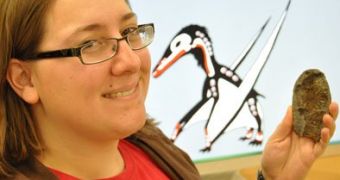A new species of flying reptile was identified on the coast of British Columbia, by a very persistent University of Alberta paleontology researcher, who after several months of research, finally concluded that the fossilized jaw bone belonged to a new species of pterosaur, a flying reptile that inhabited Earth 70 million years ago.
This fossil is not merely a new species, it's also the first pterosaur of any sort that is found in British Columbia – it was discovered on Hornby Island, off the coast of Vancouver Island.
Victoria Arbour, the paleontology researcher who made the discovery, says that 70 million years ago, when that pterosaur lived, Hornby Island was nowhere near its present location.
“In the late Cretaceous period, the British Columbia coastal islands were about 2,500 kilometers to the south and part of what is now mainland California.”
The researcher said that she was baffled when that small piece of jaw bone was first pulled from a fossil storage cabinet in the University of Alberts’s paleontology department.
“It could have been from a dinosaur, a fish or a marine reptile,” said Arbour, who is a PhD student in paleontology.
She remembered that the first time she had a clue about the species the fossil could belong to, was after she compared it to known species of pterosaurs.
“I found a previously published paper describing the teeth of a previously discovered pterosaur and ours was very close,” she said.
“The teeth of our fossil were small and set close together, they reminded me of piranha teeth, designed for pecking away at meat.”
And this is what led Arbour to believe that her new species, called Gwawinapterus beardi, was a scavenger of the late Cretaceous period.
“It had a wingspan of about three meters and patrolled the sky and set down to feed on the leftover kills made by predator dinosaurs of the time such as Albertosaurus.”
Victoria Arbour’s research was published online earlier this month, in the Canadian Journal of Earth Sciences.

 14 DAY TRIAL //
14 DAY TRIAL //